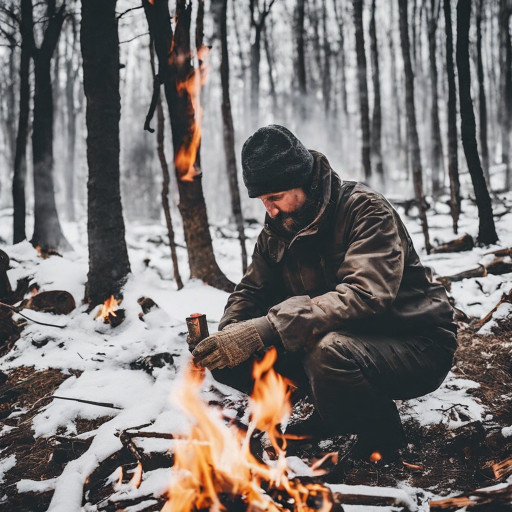Essential Strategies to Successfully Ignite Fires in Freezing Cold Weather
Starting a fire in the freezing cold is not merely a skill; it is an essential survival technique when facing the harsh realities of winter, characterized by biting temperatures and relentless winds. As a passionate survivalist, you understand that fire serves multiple critical functions: it keeps you warm, provides light, and allows for food preparation. Yet, igniting a fire in icy conditions presents unique challenges that require specific techniques and knowledge. In this comprehensive guide, we will delve into effective and reliable methods for successfully creating flames in cold weather, empowering you with the skills to withstand winter’s harsh elements and thrive in the great outdoors.
Assemble Your Fire-Starting Kit: Key Supplies for Cold-Weather Success
Before venturing into the winter wilderness, it is vital to gather the right gear and supplies that can significantly boost your survival odds. A well-prepared fire-starting kit can be the difference between warmth and discomfort during adverse weather conditions. Ensure your kit includes these essential items:

a. Firestarters: Having reliable tools like waterproof matches, storm-proof lighters, and fire-starting rods is critical to ensure ignition, even in challenging environments characterized by wind and moisture. Carrying multiple fire-starting options will instill confidence, enabling you to spark a fire no matter the circumstances you face.
b. Dry Tinder: Finding dry tinder in sub-zero conditions can be incredibly challenging. To overcome this hurdle, be sure to include highly combustible materials such as birch bark, fatwood shavings, and cotton balls soaked in petroleum jelly. These materials ignite rapidly and greatly increase your chances of successfully starting a fire when temperatures drop below freezing.
c. Kindling: To lay a solid foundation for your fire, gather dry sticks, twigs, and leaves. It's vital that these materials are completely dry; any moisture can impede ignition and lead to frustrating attempts at creating a flame. Properly prepared kindling is essential for transitioning from igniting your tinder to establishing a more robust fire.
d. Fuel: Securing dry firewood in freezing conditions can be both labor-intensive and time-consuming. Therefore, having an ample supply of dry firewood prepared in advance is crucial for maintaining a consistent fire over an extended period, ensuring your warmth and food preparation needs are met comfortably.
Select the Optimal Location for Your Fire to Enhance Burning Efficiency
When the temperature drops significantly, selecting the perfect spot for your fire can yield substantial benefits. Look for sheltered locations, such as natural rock formations or dense brush, to shield your flame from fierce winds. By positioning your fire near a natural windbreak, you can minimize heat loss and enhance the likelihood of a steady flame. Additionally, consider building a small wind-resistant shelter using logs or a tarp to protect the fire from rain and preserve warmth, ultimately improving your comfort and safety in the outdoors.
Perfect the Layering Technique for Long-Lasting and Efficient Fire Management
A key skill for successfully igniting a fire in cold conditions is mastering the layering technique with your materials. To create a fire that burns steadily, utilize three foundational layers: tinder, kindling, and fuel. Here’s a breakdown of each layer and its importance:
a. Tinder: The base layer, known as tinder, consists of materials that ignite quickly and effortlessly. Use fine, dry substances like grass, paper, or the previously mentioned birch bark to establish a strong initial flame. Having an adequate supply of tinder is crucial for achieving successful ignition, especially in frigid temperatures.
b. Kindling: This layer comprises small sticks and twigs that catch fire rapidly and provide sustained heat. Gradually introduce kindling to your flame, ensuring sufficient space between pieces to promote airflow and encourage combustion. This step is vital for transitioning from small flames to a larger, more stable fire.
c. Fuel: Once a steady flame is established, carefully add larger pieces of firewood. Ensure the wood is dry, as it will burn longer and produce more heat. Gradually increase the size of the wood pieces, allowing the flames to grow stronger before adding larger logs. This strategic layering approach fosters a stable and sustainable fire.
Utilizing the layering technique creates a structured setup that enables flames to expand and sustain themselves effectively. Always ensure you have a sufficient supply of each component readily available, facilitating a smooth transition from tinder to fuel for a successful fire in challenging conditions.
Enhance Your Fire-Starting Success with Proven Aids and Techniques
In cold weather, incorporating additional fire-starting aids can considerably elevate your chances of successfully igniting a fire amidst low temperatures. Consider the following effective methods:
a. Fatwood: Often referred to as nature’s firestarter, fatwood is resin-rich pine wood that ignites easily and burns with significant heat. You can gather these naturally occurring sticks from fallen pine trees or purchase them at outdoor supply stores. A few pieces of fatwood can greatly improve your fire-starting success, even in extremely cold conditions.
b. Alcohol-Based Hand Sanitizer: Surprisingly effective as a fire starter, alcohol-based hand sanitizer is highly flammable and acts as a potent accelerant. Applying a small amount to your tinder or kindling can facilitate quick ignition, even in damp conditions, simplifying the fire-starting process and ensuring you can stay warm when needed most.
c. Char Cloth: Char cloth is specially prepared fabric that ignites easily from sparks, making it an excellent tool for starting fires using flint and steel or a lighter in challenging situations. Its lightweight and portable nature makes it an ideal addition to your fire-starting kit, ensuring you are always prepared.
Integrating these fire-starting aids into your cold-weather toolkit can greatly enhance your success rate when confronting particularly challenging conditions, allowing you to adapt to your environment effectively.
Explore Effective Fire Techniques Designed for Cold Weather Conditions
As a committed survivalist, continually improving your skills is essential for your success. Here are two fire techniques that shine in cold weather:
a. Swedish Torch: Also known as a Canadian Candle or Finnish Fire Log, the Swedish Torch is an exceptionally effective fire-starting method. This technique produces a stable and long-lasting flame, making it ideal for combating the winter chill. To create a Swedish Torch, find a knee-height log and make several vertical cuts along its length. Fill the slits with tinder and ignite it. The log will act as a consistent fuel source, allowing the flame to last for an extended period, ensuring warmth and safety.
b. Dakota Fire Hole: In the presence of strong winds, the Dakota Fire Hole method proves highly effective. This technique entails digging a hole and tunneling horizontally underground to create an airflow vent. This design utilizes the wind to augment airflow, resulting in a more efficient fire that is less susceptible to disruption by gusts. Moreover, the Dakota Fire Hole method minimizes visible smoke while conserving fuel, making it an excellent choice for discreet fire building.
Regardless of the method you select, always prioritize safety and responsible fire management practices to reduce risks and ensure a successful fire-starting experience.
Igniting a fire in cold weather demands careful planning and execution. By following these strategies—preparing a reliable fire-starting kit, selecting an optimal location, mastering the layering technique, utilizing fire-starting aids, and applying specific fire-building strategies—you will significantly improve your odds of success. Remember, practice is key, so consistently train to hone your skills and boost your confidence. With these essential tactics for igniting fires in frigid conditions at your disposal, you’ll be well-prepared to withstand even the harshest winters nature can throw your way. Stay warm, prioritize safety, and keep the flames of survival alive!
The post Fire Starting Methods for Survivalists in Cold Weather appeared first on Survival Bite.
The Article Fire Starting Techniques for Cold Weather Survival Was Found On https://limitsofstrategy.com


I can totally relate to the frustration of trying to start a fire in the winter—one minute you’re feeling like a wilderness wizard, the next you’re wrestling with a pile of frozen sticks that seem to have a personal vendetta against your fire-making dreams. The key, I’ve found, is to keep your kindling as dry as a desert. Last winter, I made the mistake of assuming a pile of snow-covered twigs could magically transform into a roaring fire. Spoiler alert: they didn’t.
I really appreciate the insight here on starting fires in cold weather! Living in a place where winter can be pretty unforgiving, I’ve learned a few tips along the way. One that has served me well is using natural tinder—like dry pine needles or birch bark—which can sometimes be found under snow or ice. It’s like a little treasure hunt!
I can relate to that treasure hunt aspect. It can feel so rewarding to find good natural tinder hidden beneath the snow, especially when it’s cold outside. I’ve also had some success with fatwood—the resinous wood from pine trees. It lights up pretty quickly and burns hot, which can be a game changer in frigid conditions. It’s fascinating how using natural materials not only teaches you about your environment but also connects you to old survival skills.
I totally agree with you about that treasure hunt feeling. There’s something incredibly satisfying about digging through the snow to find that hidden tinder; it’s like you’re rediscovering a little piece of nature’s toolkit. I remember a trip last winter when I stumbled upon a stash of birch bark that had somehow escaped the snow. It lit up beautifully and reminded me of how useful this ancient knowledge can be, especially in the midst of challenges.
I’ve found that having the right gear makes those treasure hunts even more enjoyable, so I recently came across some essentials that really enhance your outdoor adventures.
‘Survival Backpack Essentials for Your Adventure Guide’
https://wealth-4-ever.com/survival-backpack-essentials-for-your-adventure-guide/.
This guide is really insightful, especially for those of us who often underestimate the challenges of starting a fire in freezing temps. It reminds me of my last winter hiking trip, where I had to scramble for dry tinder in a snow-covered landscape. It’s so true that having the right supplies can make a world of difference.
It’s great to hear that you found the guide helpful, especially given your own experiences in snowy conditions. The struggle for dry tinder really highlights an essential truth about winter hiking: planning ahead can significantly affect your journey.
“I’m glad you found the guide helpful! If you’re interested in enhancing your winter hiking experience, check out our curated selection of reliable fire-starting supplies that can make all the difference in those chilly conditions.”
https://wealth-4-ever.com/quillbot
Your exploration of the importance of fire-starting skills in frigid conditions resonates deeply with me, particularly as someone who has often found myself in the wilderness during winter excursions. The multifaceted role of fire in survival situations cannot be overstated, as it not only provides crucial warmth and light but also plays a vital part in morale and psychological well-being. The cold can be mentally taxing, and the comfort of a warm fire can significantly uplift one’s spirit.